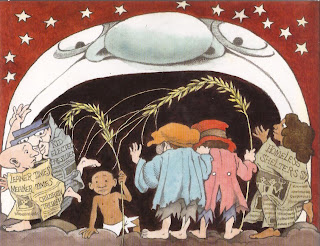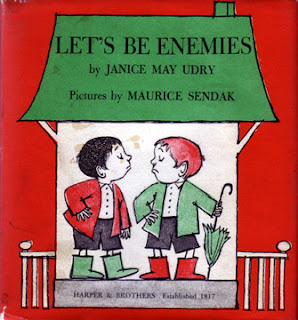In
my line of work, I come across children’s books by authors and/or illustrators
whose books are long out of print. Oftentimes,
the reason is clear; their books are either no good and weren’t even popular
when they were published, or are just horribly dated. Then there are those books I come across that
are really good, but for some reason failed to see further printings.
The latter is the case for a few
books that I read recently by Bettina [Ehrlich]. I could find no reason why her books were not
reprinted. It may have to do with rights
issues, which can sometimes be the case.
Her style could have just gone out of fashion for awhile and then just
forgotten. Another possibility is that
her most popular books were large (think Babar-Sized,
or the original Little Tim books by Ardizzone) and therefore too expensive to
reproduce. Honestly, shrinking them down
to quarto size would be an injustice.
Bettina Ehrlich was an artist and
textile designer living in Vienna, Austria.
In 1938, she and her husband, sculptor Georg Ehrlich, fled Vienna for
fear of racial persecution. They settled
in London and not long after arriving, Bettina’s first English language children’s
book, a paint-book titled Show Me Yours,
was picked up by Chatto and Windus in 1943.
In 1945 her first commercially
successful book, Cocolo, was published. It is a giant of a book, beautifully
illustrated and printed, and what’s more, it is a beautiful story. Like all of her books, the writing is
straightforward, direct and tight. This
provides a nice contrast to her artwork which is wonderfully sketch-like and
loose.
Cocolo is a little donkey who
belongs to a boy named Lucio. They live
together on a small island off the coast of Italy. One day, their little island is visited by a
rich man and his daughter, Fatimus and Fussy Greedy. (While her naming convention for the
secondary characters is heavy-handed, it does not distract from the heart of
the story.) Fussy, the daughter is so
taken with Cocolo that she begs her father to buy him from Lucio’s family and
take him back to the mainland to live on their estate. Poor Cocolo is sold off, thus his adventure
begins. Without making Cocolo humanized
or overly cute, Bettina gives Cocolo thoughts and feelings, portrayed both in
the writing and artwork, which endears him to the reader. Being forced from the little island where he
was so happy, Cocolo longs for nothing more than to get back home.
In Cocolo, we see many of the themes that will run through all of
Bettina’s books: exile, social hierarchy and the clash of rich vs. poor. Her books are all set in Italy, which for
Bettina was her place of escape in real life.
I imagine that her creation of children’s books was also her means of
escape. The effects and emotions
associated with exile ring most true in her books as it was something that she
knew so intimately.
Cocolo By Bettina [Ehrlich], Harper & Brothers, 1945
In the same year, Bettina also
published Carmello. Carmello
is one of Bettina’s best constructed stories.
The first chapter tells of Carmello’s early years, how he became blind
in one eye, but did not let that stand in his way of becoming a fisherman. In fact because he only has one eye he was
forced to see changes in the ocean unnoticed by other fishermen, which
ultimately works to his advantage. One
day while out on his boat, he manages to rescue a prized piece of jewelry for a
wealthy woman who lost it over the edge of the boat. Years later, as a widow, the woman returns
with her two granddaughters. Without
realizing who the little girls are—at first, anyway—Carmello befriends
them. In the end, Carmello is repaid for
his act of bravery and kindness so long ago, bringing the tale full
circle.
While Carmello is not of the large
and impressive size as Cocolo and
Bettina’s other books; it is as good and in some ways better, particularly in
her writing.
Carmello by Bettina [Ehrlich], Chatto & Windus, 1945
In the late
1940s, Bettina and George moved to New York for a year where Bettina prepared
the next two Cocolo books. Cocolo Comes to America and Cocolo’s Home. Both of which are set in the United States.
Cocolo
Comes to America deals directly with the current events of the time; the fleeing
of many Europeans to America at the end of WWII. Lucio and Cocolo set sail for New York City
to escape the poverty of war-ravaged Italy.
This book is filled with much more fun and wonderment than the previous
volume. We get to see such absurd things
as Cocolo, the donkey, getting into a taxi and living in a New York City
apartment. The reader rejoices along
with Cocolo as he experiences snow for the first time. Cocolo also gains a bit of fame in this book
after being hit by a car. He ends up in
an animal shelter and his story makes the evening news! There is an outpouring of support for the
little donkey from all across the country.
Cocolo Comes to America by Bettina [Ehrlich], Harper & Brothers, 1949.
After Cocolo’s Home, Bettina’s
books fell somewhat out of popularity. Pantaloni, published in 1957 is a good
story about a little boy and his dog.
While well-told and illustrated, in some ways it is a reworking of
Cocolo, just replace the donkey with a dog.
Pantaloni by Bettina [Ehrlich], Harper & Brothers, 1957.
For the Leg of a
Chicken is about a poor Italian boy, Roberto, who strives to work hard so that
he can eat chicken every day, instead of maize pudding and sardines, which is
all his poor mother can afford to feed him and his siblings. Roberto strikes off on his own to find work
in far off towns and cities. He is
sometimes tempted by others to get what he wants through mischief. Fortunately Roberto has a conscience. He meets a colorful cast of characters and
the story moves along at a lively clip.
Bettina’s artwork in this book is truly wonderful, depicting both urban
and bucolic scenes with aplomb.
For the Leg of a Chicken by Bettina [Ehrlich], Franklin & Watts, 1957.
Paolo and Panetto is my least favorite book that she
did. Unlike characters in her other
books, which were told from the point of view of an economically challenged character
struggling to make his way in the world, Paolo is a spoiled young boy. I felt no empathy whatsoever for the
character, the only problem he seems to have is that he doesn’t like going to
bed. It is not enough to engage the
reader. The story stumbles along, Paolo
meets a poor girl, chases off a bully and then for no other reason than that he
doesn’t want to climb twelve flights of stairs to go home, he sleeps in a
garden. While in the garden he
encounters the god, Pan. It’s quite
ridiculous and Pan’s dialog is so unbecoming I almost didn’t finish the
book. Paolo is eventually returned home,
but he has barely learned any sort of lesson.
There was no change in character to make his journey worthwhile, except
that he is no longer afraid to go to bed.
My last sore point with the book is that the artwork did not redeem the
story in any way; there were no large spreads, or even full-page drawings to
get lost in. It is her only book that I
would be happy to forget.

Paolo and Panetto by Bettina [Ehrlich] Franklin & Watts, 1960.
Some information
about Bettina Ehrlich and her books was taken from:
German Children’s and Youth Literature in Exile
1933-1950 by K G. Saur, 2001.































































